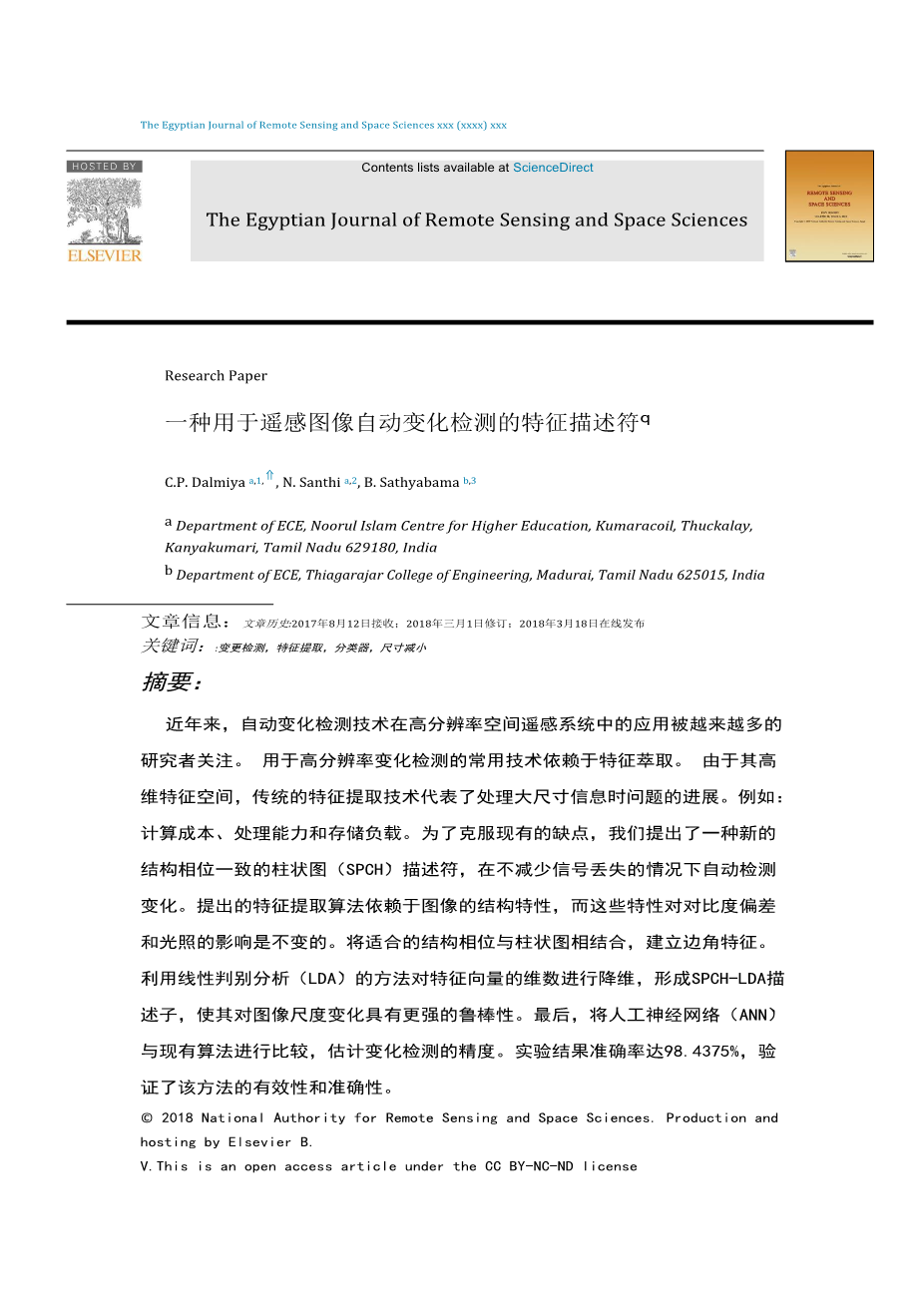The Egyptian Journal of Remote Sensing and Space Sciences xxx (xxxx) xxx
Contents lists available at ScienceDirect
The Egyptian Journal of Remote Sensing and Space Sciences
journal homepage: www.sciencedirect.com
Research Paper
A novel feature descriptor for automatic change detection in remote
sensing images q
C.P. Dalmiya a,1,uArr;, N. Santhi a,2, B. Sathyabama
b,3
a Department of ECE, Noorul Islam Centre for Higher Education, Kumaracoil, Thuckalay, Kanyakumari, Tamil Nadu 629180, India
b Department of ECE, Thiagarajar College of Engineering, Madurai, Tamil Nadu 625015, India
a r t i c l e i n f o
a b s t r a c t
Article history:
Automatic change detection has expected increasing interest for researchers in recent years on high-
spatial resolution remote sensing system where multispectral, multi-resolution and multimodal images
can be acquired. The commonly used techniques for high-resolution change detection rely on feature
extraction. Due to its high dimensional feature space, the conventional feature extraction techniques rep-
resent a progress of issues when handling huge size information e.g., computational cost, processing
capacity and storage load. In order to overcome the existing drawback, we propose a novel Structural
Phase Congruency Histogram (SPCH) descriptor for automatic change detection without reducing the sig-
nificant loss of information. The proposed feature extractor depends upon the structural properties of the
image which is invariant to contrast deviations and illumination. The structural phase congruency with
the histograms is combined to build the edge and corner features. The dimensionality of the feature vec-
tor is reduced using Linear Discriminant Analysis (LDA) to form SPCH-LDA descriptor which leads to be
more robust for image scale variations. Finally, the accuracy of the change detection is estimated with
Artificial Neural Network (ANN) as compared with the existing algorithms. The experimental results pro-
vided 98.4375% accuracy which confirms the effectiveness and superiority of the proposed technique for
automatic change detection.
Received 12 August 2017
Revised 1 March 2018
Accepted 19 March 2018
Available online xxxx
Keywords:
Change detection
Feature extraction
Classifier
Dimension reduction
Oacute; 2018 National Authority for Remote Sensing and Space Sciences. Production and hosting by Elsevier B.
V. This is an open access article under the CC BY-NC-ND license (http://creativecommons.org/licenses/by-
nc-nd/4.0/).
1. Introduction
application involved in multi-temporal datasets. Automatic change
detection expects to identify land cover variations between two
Remote Sensing images are generally utilized for viewing the
urban extension and land cover changes at a medium to enable
the advancement of urbanization and propel the practical
improvement process. In remote sensing applications, changes
are considered as surface component alterations with varying
rates. Change detection is one of the main applications of remote
sensing that quantitatively examines the temporal impacts of
registered remote sensing images obtained over the same topo-
graphical location at two diverse time moments (Neagoe et al.,
2014). The general objectives of change detection in remote sens-
ing include identifying the geographical location and type of
changes, quantifying the changes, and assessing the accuracy of
change detection results (Hussain et al., 2013). Change detection
from multi-temporal remotely sensed images is widely used in
many fields, such as land use/land cover change (Amini and
Hesami, 2017), irrigated land change (Hesami and Amini, 2016)
urban growth, forest and vegetation dynamics, and disaster moni-
toring, since many types of changes can be extracted at local, regio-
nal, and global scale (Du et al., 2013; Chen et al., 2012a,b). In
change detection of remote sensing images, the researchers mainly
focussed on change measure, and then they created methods for
classifying changed features (Liu et al., 2012).
Peer review under responsibility of National Authority for Remote Sensing and
Space Sciences.
uArr;
Corresponding author.
E-mail address: dalmiya2017@gmail.com (C.P. Dalmiya).
1
Current designation details with college name: Research Scholar, ECE Depart-
ment, Noorul Islam Centre for Higher Education, Kumaracoil, Thuckalay, Kanyaku-
mari, Tamil Nadu 629180, India.
2
Current designation details with college name: Associate Professor, ECE Depart-
Generally, change detection methods can be partitioned into
two classes: supervised and unsupervised. The supervised classifi-
cation needs learning knowledge about the study territory for
training the detection module, for example, Artificial Neural
ment, Noorul Islam Centre for Higher Education, Kumaracoil, Thuckalay, Kanyaku-
mari, Tamil Nadu 629180, India.
3
Current designation details with college name: Associate Professor, ECE Depart-
ment, Thiagarajar College of Engineering, Madurai, Tamil Nadu 625015, India.
https://doi.org/10.1016/j.ejrs.2018.03.005
1110-9823/Oacute; 2018 National Authority for Remote Sensing and Space Sciences. Production and hosting by Elsevier B.V.
This is an open access article under the CC BY-NC-ND license (http://creativecommons.org/licenses/by-nc-nd/4.0/).
Please cite this article as: C. P. Dalmiya, N. Santhi and B. Sathyabama, , The Egyptian Journal of Remote Sensing and Space Sciences, https://doi.org/10.1016/lt;
剩余内容已隐藏,支付完成后下载完整资料


英语译文共 16 页,剩余内容已隐藏,支付完成后下载完整资料
资料编号:[609471],资料为PDF文档或Word文档,PDF文档可免费转换为Word


